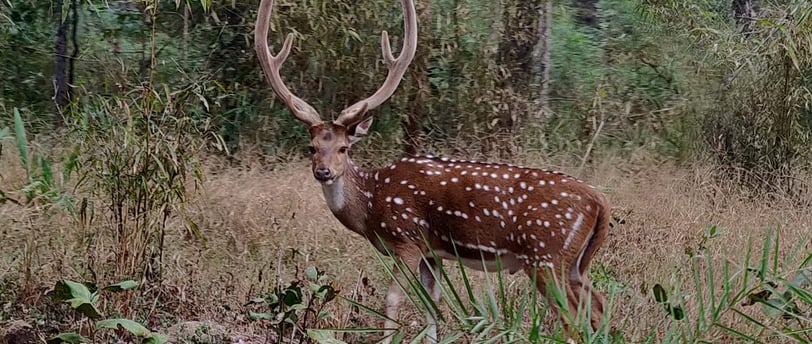Success story of Kanha Tiger Reserve
power of effective conservation strategies, community engagement, and sustainable tourism practices combined together form a unique success story


The Success Story of Kanha Tiger Reserve: Conservation, Biodiversity, and Sustainable Tourism
Introduction: Kanha Tiger Reserve, located in the central Indian state of Madhya Pradesh, is renowned as one of the most successful conservation initiatives in the country. Home to the Royal Bengal Tiger and an abundance of diverse flora and fauna, Kanha has made remarkable progress in preserving its natural heritage, promoting biodiversity, and establishing a model for sustainable tourism. In this note, we will explore the success story of Kanha Tiger Reserve, highlighting the key factors that have contributed to its achievements.
Conservation Efforts:
Tiger Conservation: Kanha Tiger Reserve has played a pivotal role in the conservation of the Royal Bengal Tiger. It was one of the first reserves in India to initiate a tiger relocation program, successfully reintroducing tigers to other habitats and helping to maintain a healthy tiger population.
Habitat Restoration: The reserve's management has focused on habitat restoration initiatives, including reforestation, controlling invasive species, and maintaining a balance between grassland and forest ecosystems. These efforts have enhanced the overall biodiversity and created suitable habitats for numerous species.
Anti-Poaching Measures: Kanha has implemented strict anti-poaching measures, including increased patrols, advanced surveillance technology, and community engagement programs. These efforts have significantly reduced poaching incidents and ensured the safety of wildlife, particularly the endangered tiger population.
Community Involvement and Sustainable Tourism:
Local Community Engagement: Kanha Tiger Reserve has actively involved local communities in conservation efforts. They have implemented community-based programs that provide alternative livelihood opportunities, such as eco-tourism initiatives, training local guides, and promoting handicrafts made by community members. This approach has created a sense of ownership and pride among local communities, making them important stakeholders in the conservation process.
Responsible Tourism Practices: Kanha has embraced responsible tourism practices to minimize its ecological footprint and ensure a positive impact on the environment and local communities. It has limited the number of tourists per day, enforced strict guidelines for wildlife encounters, and promoted eco-friendly practices among tourists and tourism operators. This sustainable tourism approach has preserved the delicate balance between wildlife conservation and visitor experiences.
Biodiversity Conservation:
Flora and Fauna Preservation: Kanha Tiger Reserve is renowned for its rich biodiversity. It is home to a wide range of flora and fauna, including the iconic Royal Bengal Tiger, Barasingha (Hardground Swamp Deer), Indian Wild Dog (Dhole), and various species of birds and reptiles. The reserve's conservation efforts have safeguarded these species and their habitats, ensuring their long-term survival.
Research and Monitoring: The reserve actively conducts scientific research, monitoring programs, and regular wildlife surveys to assess population trends, habitat quality, and the overall health of the ecosystem. These studies provide valuable insights for effective conservation management and contribute to the global understanding of biodiversity conservation.
Recognition and Conservation Partnerships:
National and International Recognition: Kanha Tiger Reserve's conservation efforts have gained national and international recognition. It has been designated as a UNESCO World Heritage Site and received numerous awards and accolades for its exemplary work in wildlife conservation and sustainable tourism practices.
Collaboration with Conservation Organizations: The reserve has established collaborative partnerships with renowned conservation organizations, research institutions, and governmental bodies. These partnerships provide technical expertise, financial support, and knowledge-sharing platforms, strengthening the conservation initiatives and ensuring the long-term sustainability of the reserve.
Conclusion: The success story of Kanha Tiger Reserve showcases the power of effective conservation strategies, community engagement, and sustainable tourism practices. By prioritizing biodiversity conservation, involving local communities, and implementing responsible tourism, Kanha has become a shining example of how conservation and sustainable development can coexist harmoniously. The remarkable achievements of Kanha Tiger Reserve serve as an inspiration for other protected areas and highlight the importance of collective efforts in preserving our natural heritage for generations to come.
